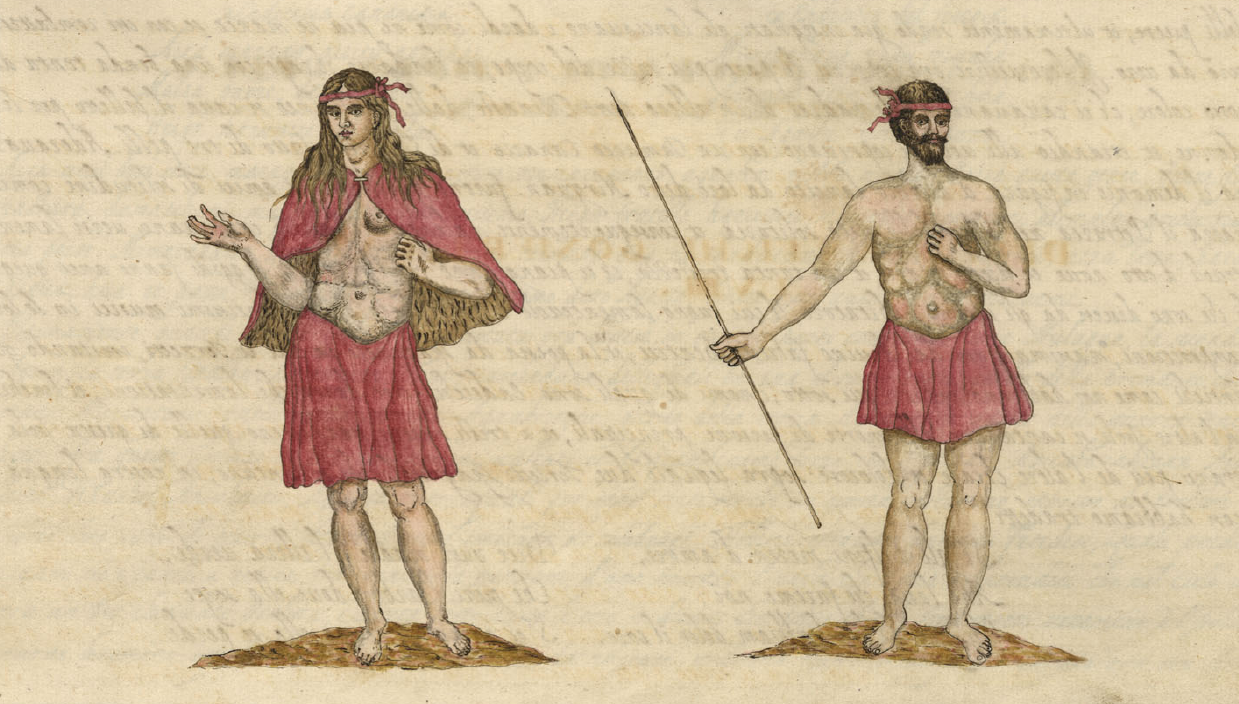
Indigenes of La Gomera, depicted by Leonardo Torriani in 1590 (source: Biblioteca Geral da Universidade de Coimbra, catalogue number Ms. 314, fol. 81r.).
To fully clarify the content of these 120 documents has been an immense job. And since an illustrious Canaryman has described me as a typical German, with a file, I must confess frankly that I own an immense one, […][1]This translation by PROYECTO TARHA.
Dominik Josef Wölfel (The Gomerans sold by Pedro de Vera and Doña Beatriz de Bobadilla, p. 23)
Present year 2018 began with very good news for Canarian historiography: the acquisition by El Museo Canario of the personal file of Professor Dominik Josef Wölfel (Vienna, 1888-1963), kept at the Institutum Canarium in Vienna. Making the most, in addition, of the recent publication of our last two posts on the Gomeran rebellion of 1488, now we issue another of our recommended essentials, which we owe to the prestigious author of the Monumenta Linguae Canariae.
Published by Dr. Wölfel in the magazine El Museo Canario in 1933, inaugurating the latter’s third editorial era, the article The Gomerans sold by Pedro de Vera and Doña Beatriz de Bobadilla is a masterful example of archival collection that, like the author himself declares in the quote above, implied a remarkable effort of search, photo taking, transcription and collation, with the Archivo General de Simancas as the main scenario. And the results could not be less but enlightening: the one hundred and twenty documents exhumed and transcribed by the Austrian ethnologist partially reveal the antecedents of the indigenous rebellion and the stark reality of the ensuing repression and slave trafficking.

Professor Dominik Josef Wölfel in 1953, flanked by Manuel Morales Ramos, President of El Museo Canario, and Matías Vega Guerra, President of the Island Council of Gran Canaria (source: El Museo Canario – catalogue number ES 35001 AMC-CFH-001015).
It is logical to assume that these documents do not represent more than the surviving part, which has reached us nowadays, of the entire process, containing mostly the claims of buyers who were ordered to release their captives because of these were Christians. Even so, the data extracted by Professor Wölfel reveal that:
- The number of both-sexes captives registered in the documents amounts 160 Gomerans plus 80 Canarians of indetermined origin.
- From this number of captives it was possible to determine the age and gender in the following cases:
- 14 men between 20 and 30 years old plus another 16, likely belonging to that same interval plus one man in his 50.
- 43 women between 14 and 40 years old.
- 42 either-gender adolescents between 10 and 15 years old.
- 41 children under 10 years old.
- Selling prices varied depending on the age and gender:
- Man adult: 3,000 – 8,000 maravedis.
- Woman between 30 and 40 years old: 4,880 maravedis (average).
- Woman between 14 and 25 years old: 5,000 – 15,000 maravedis.
- Adolescent, either gender, between 10 and 15 years old: 6,000 maravedis (average).
- Child under 10 years old: 4,300 maravedis (average).
- Sellers-buyers network consisted at least of:
- 33 residents on Gran Canaria.
- 20 residents in Sevilla.
- 12 residents in Palos.
- 11 residents in Jerez de la Frontera.
- 9 residents in Lepe.
- 9 residents in Moguer.
- 7 residents in Puerto de Santa María.
- 5 residents in Rota.
- 4 residents in Cádiz.
- 3 residents in Córdoba, Gibraltar and Sanlúcar de Barrameda.
Among the people involved, besides Pedro de Vera and Beatriz de Bobadilla, Fernando de Porras, Juan de Meneses and Pedro de Trujillo, alderman, mayor and lieutenant governor of Gran Canaria, respectively, do stand out. It should be noted, however, the name of the only trafficker mentioned by the chronicle sources, and probably the person who marketed the bulk of the captives: Juan Alonso de Cota, facedor –salesman– on behalf of Beatriz de Bobadilla, a former resident in Palos and later on La Gomera, who in 1499 reached King Fernando the Catholic a Good Friday pardon for the murder of a resident in the Andalusian village.[2]Archivo General de Simancas, catalogue number RGS,LEG,149903,51.
Antonio M. López Alonso

Pingback: El Hierro : l'arbre fontaine, de las Casas (XVIe s.) à Wölfel (1940), par Alain Gioda